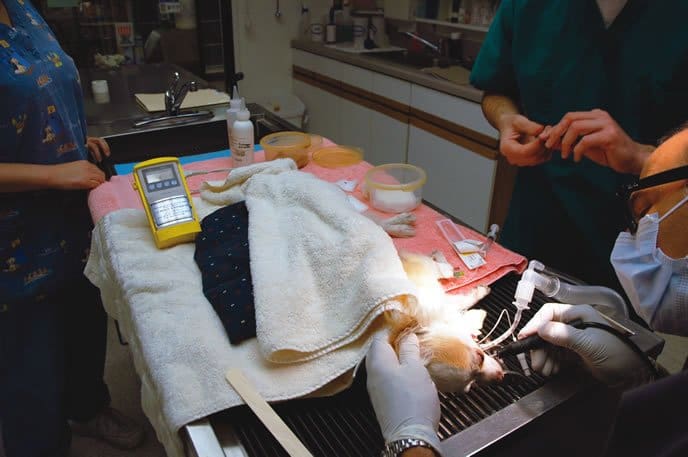
Even the biggest worrywart owner usually relaxes a bit when her dog goes to sleep – but of course, her anxiety will ratchet up to stratospheric levels if that “sleep” is the span of temporary unconsciousness known as anesthesia. The more you know about it, however, the better you should feel about this often-necessary veterinary procedure.
While it’s been compared to a state of chemically induced sleep, anesthesia is more like a reversible coma, in which your dog feels no pain, has no memory, and his muscles relax. Perhaps the most fascinating aspect of anesthesia is that scientists still don’t understand exactly how it works – other than that it somehow causes the central nervous system to be depressed, slowing down automatic functions like breathing, heart rate, circulation, and the swallow reflex.
In addition to surgeries both simple and complex, anesthesia is often used with dental procedures, as well as during certain diagnostics and treatments in which it’s important that a dog lie still.
Like any medical procedure, anesthesia poses certain risks to your dog. Be sure it is employed wisely – and not just because it’s the path of least resistance. Owners who request that their dog be anesthetized for regular nail trimming, for example, might consider that behavioral modification and gradual desensitization would be a safer, and arguably more humane, approach.

Types of Anesthesia
What types of anesthesia your veterinarian elects to use depends very much on his preferences, and your dog’s individual situation.
– Preanesthetic. Many vets will administer a mild sedative to calm a dog so he can be more easily handled and prepped for surgery. Acepromazine is commonly used, but there are many drugs, and combinations of them, that are also highly effective. Barbiturates were once widely used for this purpose, but their use as been discontinued in the United States.
– Induction anesthetic. As its name suggests, this anesthesia agent kicks off the anesthesia process. Propofol is the name that most owners will be familiar with, but, again, there are a variety of choices, depending on the veterinarian and the situation at hand. Induction anesthesia is administered intravenously (that is, with a needle); the idea is to administer a fast-acting anesthetic to pave the way for the more powerful inhalant anesthesia. The catheter that dispenses the induction agent also gives the veterinarian a conduit to provide supportive fluids – and immediate access to the bloodstream should other drugs need to be administered in response to the patient’s condition.
Because propofol works so smoothly and quickly – and can be reversed just as speedily – it is typically used to anesthetize a dog as a preparation for general anesthesia. Your vet is unlikely to use it alone during any major procedure.
“Because propofol can cause significant hypoventilation (low breathing rate) or apnea (absence of breathing), it is recommended that a patient be intubated, or have a breathing tube placed, and a supplemental oxygen source available,” explains Stuart Clark-Price, DVM, MS, DACVIM-LA, DACVAA, CVA, an assistant professor of anesthesia and pain management at the College of Veterinary Medicine at the University of Illinois at Urbana-Champaign.
There are exceptions to this rule, such as very short procedures or sedations that take less than 10 to 15 minutes, or when inhalant anesthetic isn’t possible because an endotracheal, or breathing, tube can’t be placed – for example, if the surgery is being done on the upper airway. “Propofol-only anesthesia may also be appropriate for animals with suspected brain tumors,” he adds, “as propofol may maintain proper blood flow to the brain more than inhalant anesthetics in this population of patients.”
– Inhalant anesthetic. This is what most of us think of when we hear the word “anesthesia” – a gas anesthetic. Inhalant anesthesia requires a breathing tube, which is placed in the trachea to ensure that the dog gets the proper levels of anesthetic, as well as oxygen, during the surgery.
Today, most veterinary practices use isoflurane and sevoflurane (colloquially referred to as “iso” and “sevo” for short).
“Isoflurane is the most commonly used gas anesthesia for canines in the United States. Sevoflurane is a newer agent that is also commonly used,” explains Dr. Clark-Price. “There is very little difference between the two agents as far as safety. Both cause clinically significant vasodilation and decreased blood pressure. So owners should ask if their veterinarian monitors blood pressure during anesthesia.”
“Masking down” is a procedure where the veterinarian skips the induction agent, and simply anesthetized the dog with the inhalant anesthesia, placing the mask over the face until the anesthesia kicks in. One downside to this approach is that there is typically a period of excitement or struggle before the dog succumbs to the anesthesia, which can be stressful for the vet staff, to say nothing of the dog.
“‘Masking down’ is just one way to induce general anesthesia, and it can be used safely unless rapid control of the airway is desirable – for example, in a patient at risk for regurgitation or vomiting – since mask induction takes several minutes,” explains Bruno Pypendop, DrMedVet, DrVetSci, DACVAA, professor and service chief of anesthesiology at the School of Veterinary Medicine at the University of California, Davis.
“However,” he adds, “many veterinary anesthesiologists, including myself, prefer not to use this technique unless there is no alternative. The reasons for this include the stress imposed on the patient, the poor control of the patient for several minutes, time it takes before you can place a tube in the trachea and gain control of the airway, and the exposure of personnel to anesthetic vapors.”
Post-Operative Pain Management
Only a few decades ago, canine surgery patients were released with only a pat on the head; today, veterinarians are very aware of post-surgical pain, and it is standard practice to prescribe medication to help relieve it. Dr. Clark-Price suggests asking your vet what protocol he or she uses for pain. “Multimodal approaches to pain management” – that is, using several medications, which reduces the amount of each individual drug used, and can prove safer – “can help alleviate pain associated with surgical procedures as well as shorten recovery time so that an animal can be returned to his owner sooner and get back to his usual routine.”
In fact, owners should ask what drugs will be used throughout the anesthesia process. In anesthesia as well as pain management, a multi-modal approach is often advisable, Dr. Clark-Price continues. “Are they ‘preoxygenating’ the patients – providing supplemental oxygen prior to inducing anesthesia? Do they intubate their patients and use gas anesthesia or do they use a strictly injectable protocol? Do they have established protocols for emergencies?”
Risks of Anesthesia
The risk of death for dogs undergoing anesthesia is approximately 0.1 percent. That doesn’t sound like very much until you translate it into whole numbers: One in 1,000 dogs undergoing surgery will die from an anesthetic-related problem. That’s 10 times higher than the mortality risk in humans, which is 0.01 percent, or one in 10,000.
A study conducted about 10 years ago from the United Kingdom estimated the overall risk of anesthesia-related deaths in dogs to be even higher – 0.17 percent, or about one in 600 cases – though advances in veterinary medicine over the decade may have lowered that number.
Before you panic, Dr. Clark-Price reminds that those are just averages.
“The actual rate at a specific hospital depends on many factors, including equipment, experience, anesthetic drugs used, if a person is dedicated specifically to monitoring a patient during anesthesia, and the health status of the patient,” he says. “Hospitals with anesthesiologists probably tend to have lower mortality rates than those that don’t.”
Your dog’s general state of health affects the chance that complications may develop, which is just common sense: A sick dog is at higher risk than a healthy one. Specific procedures also carry specific risks. For example, Dr. Clark-Price says, “a dog that is having a spay will have less risk than a dog having its spleen removed because of cancer.”
Dr. Clark-Price lists five common risks for patients undergoing anesthesia: hypotension (low blood pressure), hypoventilation (reduced depth and frequency of breathing, hypothermia (low body temperature), bradycardia (slow heart beat) and pain (the degree changes, depending on the procedure).
While different types of anesthesia are associated with certain risks, there are more important factors involved in assuring that your dog comes out of surgery successfully.
Dr. Pypendop offers this quote from Dr. Robert Moors Smith, a pioneer of modern anesthesia practice in people: “There are no safe anesthetic agents, there are no safe anesthetic procedures, there are only safe anesthetists.”
In other words, how anesthesia is used, and how the patient is supported and monitored throughout the process, is what matters most.
“The veterinarian and their technicians’ knowledge and training are more important than which specific drug they use,” Dr. Pypendop says. “That is why there are specialist training programs in anesthesia for both veterinarians and veterinary technicians.”
Monitoring
Both Drs. Clark-Price and Pypendop stress that monitoring is the best way to prevent problems associated with anesthesia. Keeping a close tab on certain bodily functions, such as respiration and heart rate, allows veterinarians to detect problems early, and prevents them from progressing to the point where they become critical or life threatening.
For an idea of just how important monitoring is in avoiding complications, Dr. Clark-Price points to the four main monitors used during human surgeries: electrocardiogram (which measures the electrical activity of the heart), pulse oximetry (how much oxygen is in the blood), blood pressure, and end tidal gas monitoring (how well a patient is breathing during anesthesia). When those four monitors are used in human medicine, “it reduces the chances of avoidable anesthetic complications by 96 percent!” he says. “Many veterinary practices have one or more of these monitoring devices, and clients should ask their veterinarians if they are using any of them.”
But Dr. Pypendop notes that sometimes, an experienced eye can be even more critical than a high-tech approach.
“When mentioning monitoring, people often think of ‘machines that beep,’ but in my opinion, while these devices are helpful, having a trained individual dedicated to monitor each patient is the best way to avoid complications,” he says.
Most veterinary practices do not have a board-certified anesthesiologist on staff; instead, anesthesia monitoring typically falls to a veterinary technician, who is supervised by the veterinarian. Vet techs can be certified in anesthesia management. Make sure to ask your veterinarian about who will be assisting with surgery, and if that person is board certified (in cases where the anesthetist is a veterinarian) or has received any specialized training in anesthesia administration (in cases where the anesthetist is a veterinary technician).
If your dog is at risk for anesthesia-related complications, consider asking your veterinarian to consult with a veterinary-anesthesia specialist who has been certified by the American College of Veterinary Anesthesia and Analgesia. In the end, you and your vet might decide that the best course is to have the procedure done with a board-certified anesthesiologist in attendance, most likely at a specialty practice or university hospital.
Breed-Specific Concerns
Dr. Pypendop notes that there are “many unsubstantiated, likely baseless” reports of breed sensitivities to a particular drug or series of drugs floating around on the blogosphere. But some are legitimate. Even if your dog a good old “all American” canine, considering what breeds might be in his background might be useful when it comes to calculating anesthesia risks.
“The only well-documented, breed-specific anesthetic drug concern is with the use of thiobarbiturates in Greyhounds,” Dr. Pypendop says. But that sensitivity – which is believed to affect all lithe-bodied breeds created for chasing prey at high speeds, such as Whippets and Borzoi – is a moot point since that class of sedatives is not available in the United States anymore. Anecdotally, sighthounds have been found to have prolonged recoveries from other drugs, too, and their low stores of body fat leave them susceptible to hypothermia, or lowered body temperature, while anesthetized.
Dr. Clark-Price notes that Arctic breeds such as Siberian Huskies and Alaskan Malamutes typically experience a great deal of disorientation – formally called dysphoria – during recovery from anesthesia. “They may require additional sedation until they have fully cleared the anesthetic drugs from their systems,” he says. Ideally, your veterinarian will have a “recovery room” that is dimly lit and quiet, away from noises and activity that could agitate recovering patients even further.
Dr. Pypendop ticks off a laundry list of other breed tendencies to keep in mind with anesthesia: Certain herding breeds, such as Australian Shepherds, Collies, and Border Collies, carry a genetic mutation that makes them more sensitive to some drugs, including those used for sedation and anesthesia. Some breeds are predisposed to diseases that can increase anesthesia risks; miniature Schnauzers, for example, have a relatively high incidence of sick sinus syndrome, which creates heart-rhythm problems, or arrhythmias. And some Boxers appear to be sensitive to acepromazine.
“Size plays an important role, as smaller and toy breeds are at a higher risk for hypothermia during and after anesthesia,” Dr. Clark-Price says. Regardless of breed, your veterinarian should provide warming blankets or other heat support during surgery, to keep your dog’s body temperature from plummeting.
“And brachycephalic breeds – Pugs, Bulldogs, anything with a ‘smashed’ face – may have difficulty with airway management during and after anesthesia,” he continues. “These animals may require very close monitoring after anesthesia to make sure they do not obstruct their airways.”
What You Can Do
Most dog owners know that withholding food and water before anesthesia is standard procedure; typically, your veterinarian will ask you to start fasting your dog at midnight on the day of surgery.
“Adequate fasting is important to limit the incidence of vomiting, regurgitation, or gastroesophageal reflux during anesthesia,” Dr. Pypendop explains.
Let your vet know about any medications you are giving your dog – including herbal supplements and nutraceuticals – and ask for guidance on what you should and should not give on the day of surgery.
Many vets will require or strongly suggest that pre-operative bloodwork be done to ensure that there are no imbalances or underlying conditions that could complicate surgery. (See our article about blood tests, “It’s in the Blood,” WDJ March 2015.)
Dr. Clark-Price notes that obesity is a risk factor for complications during anesthesia, and for some elective procedures, it might be advisable for your dog to take off a few pounds before going under. The best way to decide if postponement is the best option is in consultation with your veterinarian, who should also be involved in any weight-loss program you implement.
Though owners are understandably anxious to get their dogs back home after surgery, Dr. Pypendop warns against “rushing the procedure.” Instead, give your veterinarian time to adequately monitor your dog’s post-anesthesia recovery. That said, “some individuals may be extremely anxious in a hospital environment,” he says, “so optimal care should be decided on a case-by-case basis.”
With plenty of communication and a little research, you can let your dog undergo anesthesia with the confidence that he’ll emerge from his big fat nap none the worse for wear.
Denise Flaim of Revodana Ridgebacks in Long Island, New York, shares her home with three Ridgebacks, teenaged triplets, and a very patient husband.






It was interesting when you talked about how propofol is usually used to prepare a dog for general anesthesia and is rarely used alone. My husband and I are currently looking for a reputable pet surgeon because our three-year-old black lab needs surgery on his knee. I’m glad I read your article and learned how to talk with different surgeons about the types of anesthesia they use during their procedures.
“The only well-documented, breed-specific anesthetic drug concern is with the use of thiobarbiturates in Greyhounds,”
You may want to add that there are dogs with MDR1 gene mutations that are reactive to sedatives, specifically collies and Australian shepherds. Research is done by WSU and it is well documented.
I took my male dog for a neuter today and I believe the doctor only used propofol on him. His eyes were open and his tongue was out during the surgery. The doctor took about 10 minutes to neuter him. Is that safe? I read that neutering should be under general anesthesia and that really got me confused when I saw my dog with his eyes open.
Wonderfully detailed article!!! I only wish that ALL WDJ readers would read the COMPLETE article, and then ask for clarification/education about specific technical aspects of aneasthesia that they don’t understand. Your partnership with your veterinarian assures the best possible outcome for your companion, even if general anesthesia is needed!
I have a Yorkie poo and she is 13.5 years old. She has had minor seizures for probably about 10 years. It has really been hard for me to brush her teeth and with her having seizures, I’ve been scared to have her teeth cleaned by the vet because of the anesthesia. She now has an infection in her gums and the vet says she needs to have dental work. Is there a pill or some other alternative they can use instead of anesthesia?